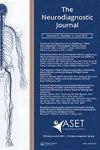Waveform Window #54: Alpha-Delta Sleep.
Q3 Health Professions
The Neurodiagnostic Journal
Pub Date : 2023-09-01
Epub Date: 2023-08-01
DOI:10.1080/21646821.2023.2235955
引用次数: 0
Abstract
Alpha-delta sleep is an abnormal rhythm that occurs in slow wave sleep (stage N3) characterized by alpha waves intruding on delta waves and is observed in patients with chronic insomnia, or a chronic pain condition such as fibromyalgia (Van Hoof et al. 2007). Researchers have also linked alpha intrusion to anxiety. An example of this can be a patient exhibiting hypervigilance, which is a sensitivity to the environment including sounds, movements, and changes in surroundings; this hypervigilance can persist in sleep (Van Hoof et al. 2007). When the patient reaches N3 sleep, alpha waves become superimposed on delta waves. Alpha-delta sleep has been studied extensively by polysomnography, but there are few EEG examples with a full array of 10–20 electrodes in the current literature.波形窗口#54:阿尔法-德尔塔睡眠。
本文章由计算机程序翻译,如有差异,请以英文原文为准。
求助全文
约1分钟内获得全文
求助全文
来源期刊

The Neurodiagnostic Journal
Health Professions-Medical Laboratory Technology
CiteScore
1.00
自引率
0.00%
发文量
26
期刊介绍:
The Neurodiagnostic Journal is the official journal of ASET - The Neurodiagnostic Society. It serves as an educational resource for Neurodiagnostic professionals, a vehicle for introducing new techniques and innovative technologies in the field, patient safety and advocacy, and an avenue for sharing best practices within the Neurodiagnostic Technology profession. The journal features original articles about electroencephalography (EEG), evoked potentials (EP), intraoperative neuromonitoring (IONM), nerve conduction (NC), polysomnography (PSG), autonomic testing, and long-term monitoring (LTM) in the intensive care (ICU) and epilepsy monitoring units (EMU). Subject matter also includes education, training, lab management, legislative and licensure needs, guidelines for standards of care, and the impact of our profession in healthcare and society. The journal seeks to foster ideas, commentary, and news from technologists, physicians, clinicians, managers/leaders, and professional organizations, and to introduce trends and the latest developments in the field of neurodiagnostics. Media reviews, case studies, ASET Annual Conference proceedings, review articles, and quizzes for ASET-CEUs are also published in The Neurodiagnostic Journal.
 求助内容:
求助内容: 应助结果提醒方式:
应助结果提醒方式:


